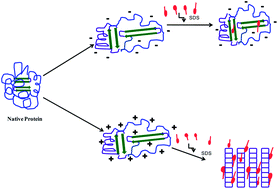Protonation favors aggregation of lysozyme with SDS
Abstract
Different proteins have different amino acid sequences as well as conformations, and therefore different propensities to aggregate. Electrostatic interactions have an important role in the aggregation of proteins as revealed by our previous report (J. M. Khan et al., PLoS One, 2012, 7, e29694). In this study, we designed and executed experiments to gain knowledge of the role of charge variations on proteins during the events of protein aggregation with lysozyme as a model protein. To impart positive and negative charges to proteins, we incubated lysozyme at different pH values of below and above the pI (∼11). Negatively charged SDS was used to ‘antagonize’ positive charges on lysozyme. We examined the effects of pH variations on SDS-induced amyloid fibril formation by lysozyme using methods such as far-UV circular dichroism, Rayleigh scattering, turbidity measurements, dye binding assays and dynamic light scattering. We found that sub-micellar concentrations of SDS (0.1 to 0.6 mM) induced amyloid fibril formation by lysozyme in the pH range of 10.0–1.0 and maximum aggregation was observed at pH 1.0. The morphology of aggregates was fibrillar in structure, as visualized by transmission electron microscopy. Isothermal titration calorimetry studies demonstrated that fibril formation is exothermic. To the best of our current understanding of the mechanism of aggregation, this study demonstrates the crucial role of electrostatic interactions during amyloid fibril formation. The model proposed here will help in designing molecules that can prevent or reverse the amyloid fibril formation or the aggregation.


 Please wait while we load your content...
Please wait while we load your content...